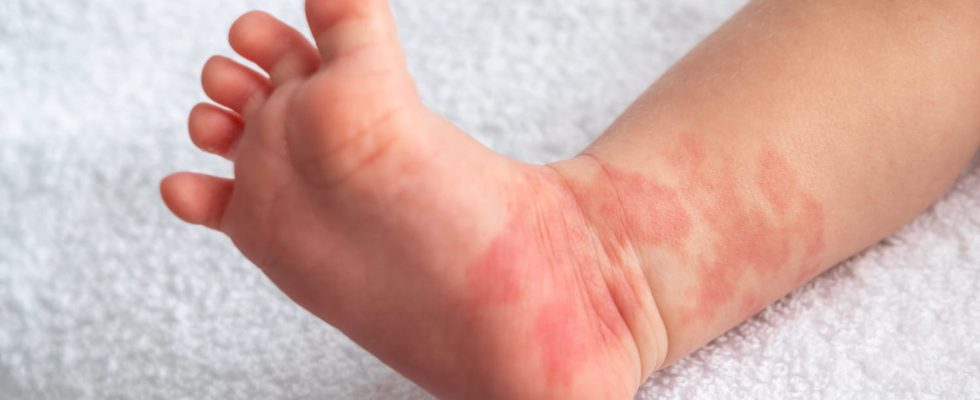Brown, blue, salmon… Some birthmarks mark baby’s skin on the face, neck or body. Most are safe, but some should be checked out by a doctor. Insight with Pr Annabel Maruani, pediatric dermatologist and venerologist.
At birth or later, a baby may have on the skin, somewhere on the body, a birth mark. In reality, it is one or more skin lesions. Most birthmarks have a color (brown, salmon, red, blue, etc) that stands out from the color of the child’s skin. These marks on the skin babies are often benign. How are birthmarks formed? When do they appear and in which cases to worry? The advice of Pr Annabel Maruani, dermatologist and pediatric venerologist at the University Hospital of Tours.
What is a birthmark?
The term birthmark covers a wide variety of skin lesions which have the characteristics of being congenital, that is to say present at birth, of being flat and generally fairly well demarcated. They can be single or multiple and be located on any part of the body (face, neck, body, trunk). Birthmarks can be white, that is to say hypopigmented or even depigmented, red (vascular), or brownindicating the existence of melanin.
What are the different types of birthmark in babies?
There are several types of birthmarks:
white birthmark
Those white birthmarksthey are also called hypo- or depigmented spots, which are devoid of pigment.
Brown birthmark
The brown spots come in two main varieties: café au lait spots which contain a little more melanin in the skin and which are completely flat; moles or congenital nevi which are a little thicker and can change a little over time.
red birthmark
The red spots are for the majority flat angiomas, that is to say small vascular anomalies, indicating that there are more capillary vessels at the level of the dermis, revealing the red appearance by transparency of the blood vessels.
blue birthmark
Blue or blue-gray spots are so-called Mongoloid pigment spots. They are frequently found in children of color, mixed race, in a round or “ovoid” shape at the level of the sacrum and the coccyx. They “can be single or multiple, classically, they are benign and limited, they appear at birth or in the first months of life and disappear spontaneously before puberty”, noted the journal article Pan African Medical Journalpublished on the National Library of Medicine website, and written by doctors Rachid Abilkassem and Aomar Agadr.
Salmon birthmark
THE salmon birthmarks, or light pink, also called “kiss of the angels” or “stork bite” are quite common in babies who have a pale complexion. At birth, they are usually located on the child’s face, on the forehead, but they can also appear on the back of the neck.
What are birthmarks caused by?
Causes of birthmarks vary depending on their nature. “Some are linked to genetic diseases, others are completely isolated and their cause remains unknown. Still others, like large flat angiomas (or wine spots), are linked to genetic mutations on the affected area only (so-called somatic mutations) and are neither transmitted nor transmissible”, explains Professor Annabel Maruani.
“Birthmarks are not related to food cravings or frustrations or pregnancy shocks.”
When do birthmarks appear?
As their name suggests, birthmarks are usually present from birth. “It is not easy to date them precisely, to know at what point in embryonic or fetal life they appeared. Sometimes certain spots are conditioned from birth to appear, but do not reveal themselves until later in life. life, most often in early childhood“, underlines the dermatologist-venerologist.
Are birthmarks hereditary?
“Except in rare cases of particular genetic conditions, birthmarks are not hereditary. So when parents find that their child has a birthmark like them, it’s usually fortuitous.” notes the specialist.
When to worry about a birthmark?
“The skin patch itself is usually not dangerous, but sometimes it can be the telltale sign of an illness which can be annoying for the child. For example, a large red spot (angioma plan) on the face reaching the forehead may reveal a Sturge-Weber syndrome, which associates an angioma in the meninges and possibly in the eye. As for the risk of cancer, birthmarks of a cancerous nature are truly exceptional“, reassures the expert.
On the other hand, if the appearance, size or color of the baby’s birthmark changes, you should consult and to seek the advice of their attending physician, pediatrician or dermatologist.
Do birthmarks disappear in adulthood?
Birthmarks rarely disappear in adulthood. Occasionally, café-au-lait spots lighten up a little, but in the majority of cases, they persist into adulthood.
Thanks to Pr Annabel Maruani, pediatric dermatologist and venerologist at the CHRU de Tours.
- Extensive Mongoloid spot, by Rachid Abilkassem and Aomar Agadr. National Library of Medicine (October 6, 2013). : https://www.ncbi.nlm.nih.gov/pmc/articles/PMC3951786/#:~:text=The%20spots%20mongolo%C3%AFof%20are%20,in%20%20children%20of%20color .
